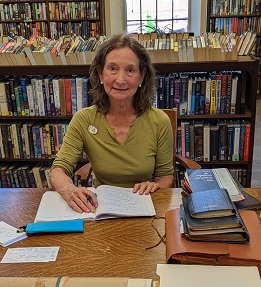Busting the myth of the “solitary” writer.

One of the newspapers I read runs a regular feature called “Myth Busting.” Sometimes, it blows up a bit of local history. Other times, it debunks the efficacy of a common practice or the accuracy of high-volume sound bites on a hot issue.
Today, I’d like to bust the myth of writing as a lonely pursuit.
Writing does require solitude, but both the process and the product connect me to others. I meet writers in the real or virtual world; I encounter readers in person or online. Writing also requires solitude for reading the work of others. And reading as a writer intensifies my connection to authors, especially those who remain alive on the page though long gone from the world.
Solitude can be a scarce commodity. Most of the year, I’m in city-mouse mode. Step out of our apartment door with the recycling? Meet a hall neighbor. Head down to the basement to the laundry? Chat with another. I have the writer’s essential luxury, a room of her own, but the distractions of company — husband, friends, neighbors — are always close at hand.
So, in fair-weather months, I go country-mousing up to an old farm in the foothills of the Alleghenies. I engineer solo writing retreats, weeks of solitude to dig into work in progress. Setting out on these self-imposed exiles, I’m apprehensive.
I should know better, but I buy into the myth of the lonely writing life.
Yet once here, I rediscover the difference between loneliness and solitude and reacquaint myself with the abundant good company of nature: birds and critters, cloud shows, sunrises, sunsets, stars, and weather.
Tasks like recycling and laundry are not interactive here. The recycling center is an unattended bin near the lake where I swim. The laundromat’s 10 miles down the road in town, but I handwash using my late mother’s system: buckets for suds and rinse, a clean toilet plunger labeled LAUNDRY for a mangle. The only neighbors in my outdoor laundry room are hummingbirds and chipmunks.
But please, don’t picture me cut off from so-called civilization. Cell towers sprout on the mountaintop, and service is good. Years back, we had a party line and screamed or whistled into the phone if we had an urgent call that required breaking into someone’s chatter. Still, it remains a rural Wi-Fi desert. Connecting to the internet via cellphone hotspot is possible, but the cumbersome fiddle eats data.
For writing, that inconvenience is good. I save my work at the end of a session but avoid browsing. If a personal email isn’t time-sensitive, I break out my green Hermes 3000 manual typewriter and write a letter. Did Coca-Cola promise “the pause that refreshes”? Solitude and slow communication provide pause for reflection.
Good neighbors live a mile away on the ridge, friends down in the valley, and others in the town 10 traffic-free miles away. Some of these folks I met through my writing. My first novel, set in this region, has connected me to local readers, like a book-child emissary for her author-parent.
Still, beyond waving at the occasional passing car, pickup truck, or bicyclist, most socializing here requires intention. Chance encounters are surprises, not routine, like seeing a friend yesterday by the village pump. I filled bottles with drinking water from the artesian spring as we chatted.
One of the benefits of writerly solitude is uninterrupted conversations with myself about the work and, much more interesting, conversations with my characters. Whether charming or difficult, ingratiating or exasperating, imagined or partly inspired by a real person, I must know and care for a character to write her.
Now, I’m in the process of populating another novel set in this region, inspired by a 19th-century artist and his family. It was research heaven to visit a county history archive and a town library, to delve into newspapers, diaries, and letters.
Driving home through the fields and up the ridge, I followed my usual route, but I’d learned one of my characters had driven here, too, and had a drink in the village. The past and the present overlapped as she kept talking. By the end of the day, I needed quiet to put notes and thoughts in order.
Yes, writing is far from a lonely pursuit!
One can have enough of a good thing, though, even solitude. Today, I welcomed my husband’s arrival from the city. After lunch on the porch, he headed for the hammock, napping and rereading a book he’d read here many summers ago.
From my writing room, I glimpse him beneath the walnut trees. We’re reading and writing, together and separate. Protecting each other’s solitude, as Rilke said.
Ellen Prentiss Campbell’s collection of love stories is Known By Heart. Her story collection Contents Under Pressure was nominated for the National Book Award, and her debut novel, The Bowl with Gold Seams, won the Indy Excellence Award for Historical Fiction. Her novel Frieda’s Song was published last May. Her column, “Girl Writing,” appears in the Independent bi-monthly. For many years, Campbell practiced psychotherapy. She lives in Washington, DC, and is at work on another novel.

